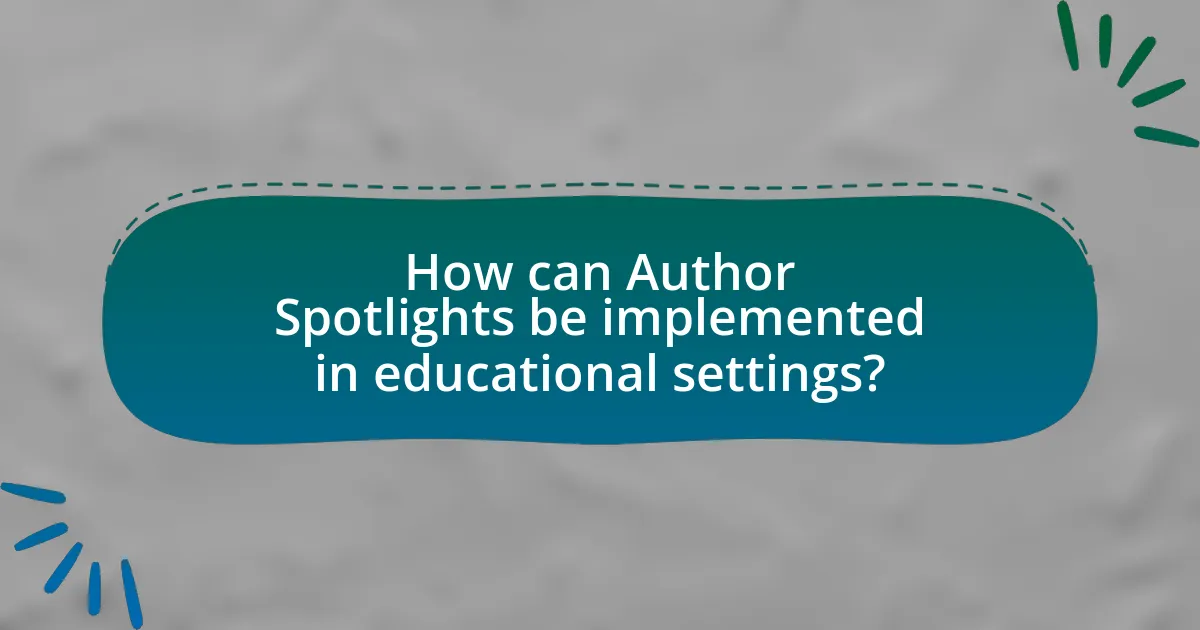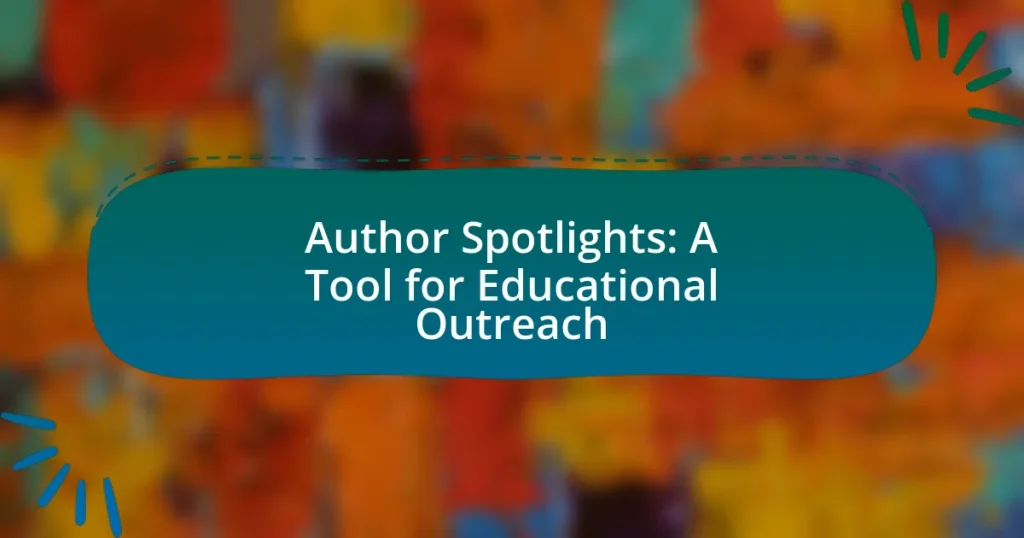Author Spotlights are focused presentations that highlight the contributions of specific authors within educational contexts, aiming to engage learners by showcasing diverse voices and perspectives. These spotlights enhance learning experiences by providing insights into authors’ thoughts and processes, fostering critical thinking and a deeper understanding of literature. Effective Author Spotlights incorporate engaging biographical information, clear presentations of the authors’ works, and insights into their writing processes, catering to various learning styles through multimedia elements. They are crucial for educational institutions as they promote literacy, broaden cultural understanding, and inspire a love for reading among students. The article also addresses the implementation of Author Spotlights, strategies for engagement, and the challenges educators may face, providing practical tips for maximizing their impact in educational outreach.

What are Author Spotlights and their purpose in educational outreach?
Author Spotlights are focused presentations or features that highlight the work and contributions of specific authors, particularly in the context of educational materials. Their purpose in educational outreach is to engage learners by showcasing diverse voices and perspectives, thereby enhancing the relevance and relatability of educational content. By featuring authors, educational institutions can foster a deeper connection between students and the material, encouraging critical thinking and discussion around the themes presented in the authors’ works. This approach not only promotes literacy but also supports the inclusion of varied cultural and social narratives in educational settings.
How do Author Spotlights enhance learning experiences?
Author Spotlights enhance learning experiences by providing students with direct insights into the thoughts and processes of authors, which fosters a deeper understanding of the material. This engagement allows learners to connect with the content on a personal level, making the learning process more relatable and impactful. Research indicates that when students are exposed to the backgrounds and motivations of authors, they are more likely to develop critical thinking skills and a greater appreciation for diverse perspectives in literature. For example, studies show that author interviews and discussions can lead to improved comprehension and retention of information, as students are able to contextualize the material within the author’s experiences and intentions.
What elements make an Author Spotlight effective?
An effective Author Spotlight includes engaging biographical information, a clear presentation of the author’s work, and insights into their writing process. Engaging biographical information captures the audience’s interest and establishes a connection, while a clear presentation of the author’s work highlights key themes and contributions, making it easier for readers to understand the significance of the author’s contributions. Insights into the writing process provide depth, allowing readers to appreciate the effort and creativity involved in the author’s work. These elements collectively enhance the educational outreach of the Author Spotlight by fostering a deeper understanding and appreciation of the author’s contributions to their field.
How do Author Spotlights cater to diverse learning styles?
Author Spotlights cater to diverse learning styles by providing varied content formats that engage different types of learners. For instance, visual learners benefit from images and videos of authors, while auditory learners can engage with podcasts or interviews. Kinesthetic learners may find interactive elements, such as Q&A sessions or live discussions, particularly effective. Research indicates that incorporating multiple modalities in educational content enhances retention and understanding, as supported by the VARK model of learning styles, which emphasizes the importance of addressing visual, auditory, reading/writing, and kinesthetic preferences. This multifaceted approach ensures that Author Spotlights resonate with a broad audience, accommodating individual learning preferences effectively.
Why are Author Spotlights important for educational institutions?
Author Spotlights are important for educational institutions because they enhance student engagement and promote literacy by showcasing diverse authors and their works. By highlighting authors, institutions can provide students with relatable role models and broaden their understanding of different cultures and perspectives. Research indicates that exposure to diverse literature can improve empathy and critical thinking skills among students, fostering a more inclusive learning environment. Furthermore, Author Spotlights can stimulate interest in reading and writing, as students often feel inspired by the stories and experiences of the authors featured.
What role do Author Spotlights play in promoting literacy?
Author Spotlights play a significant role in promoting literacy by showcasing diverse authors and their works, which can engage readers and inspire a love for reading. By highlighting the backgrounds, writing styles, and themes of various authors, these spotlights can make literature more relatable and accessible, particularly for young readers. Research indicates that exposure to a variety of authors can enhance students’ understanding of different cultures and perspectives, thereby fostering critical thinking and empathy. For instance, initiatives like the “We Need Diverse Books” campaign emphasize the importance of representation in literature, which has been shown to improve literacy outcomes among underrepresented groups.
How can Author Spotlights foster a love for reading among students?
Author Spotlights can foster a love for reading among students by showcasing the lives and works of authors, making literature more relatable and engaging. When students learn about an author’s background, inspirations, and writing processes, they develop a personal connection to the stories, which enhances their interest in reading. Research indicates that when students see authors as real people with unique experiences, their motivation to read increases, as evidenced by a study from the National Literacy Trust, which found that author engagement can significantly boost students’ reading enjoyment and frequency.

How can Author Spotlights be implemented in educational settings?
Author Spotlights can be implemented in educational settings by integrating them into curriculum activities that promote reading and writing engagement. Educators can feature specific authors, providing students with background information, discussing their works, and facilitating related projects or discussions. This approach enhances students’ understanding of literary styles and encourages critical thinking about the themes and contexts of the authors’ works. Research indicates that author studies can improve students’ reading comprehension and foster a deeper appreciation for literature, as seen in programs that have successfully utilized author spotlights to increase student interest and participation in reading activities.
What strategies can educators use to create impactful Author Spotlights?
Educators can create impactful Author Spotlights by incorporating interactive elements, utilizing multimedia resources, and fostering community engagement. Interactive elements, such as Q&A sessions or live readings, encourage student participation and enhance interest. Utilizing multimedia resources, like videos or podcasts featuring the author, can provide diverse ways to engage with the material, making it more accessible and appealing. Fostering community engagement through book clubs or author visits can deepen connections between students and authors, enriching the educational experience. These strategies are supported by research indicating that interactive and multimedia approaches significantly improve student engagement and retention of information.
How can technology enhance the presentation of Author Spotlights?
Technology can enhance the presentation of Author Spotlights by utilizing multimedia elements such as videos, interactive graphics, and social media integration. These tools allow for a more engaging and immersive experience, capturing the audience’s attention effectively. For instance, incorporating video interviews with authors can provide personal insights that text alone cannot convey, making the spotlight more relatable. Additionally, interactive graphics can illustrate an author’s journey or key themes in their work, facilitating better understanding. Social media platforms can amplify reach and engagement, allowing audiences to interact with authors directly, fostering a community around their work. These enhancements lead to a richer educational outreach experience, making Author Spotlights more impactful.
What resources are available for developing Author Spotlights?
Resources available for developing Author Spotlights include author interviews, social media platforms, and publishing industry databases. Author interviews provide firsthand insights into the author’s work and background, enhancing the spotlight’s depth. Social media platforms like Twitter and Instagram allow for direct engagement with authors and their audiences, facilitating the sharing of spotlight content. Additionally, publishing industry databases, such as Publishers Weekly and Booklist, offer valuable information on authors’ bibliographies and critical reception, which can enrich the spotlight’s context. These resources collectively support the creation of informative and engaging Author Spotlights for educational outreach.
How can collaboration with authors improve educational outreach?
Collaboration with authors can significantly enhance educational outreach by leveraging their expertise and credibility to create engaging and informative content. When authors contribute their knowledge, they provide unique insights that can resonate with diverse audiences, making educational materials more relatable and impactful. For instance, research shows that incorporating expert voices in educational programs increases learner engagement and retention rates, as seen in studies conducted by the National Education Association, which found that students are more likely to connect with content that features real-world applications and expert perspectives. This collaboration not only enriches the educational experience but also fosters a sense of community and shared learning between authors and learners.
What benefits arise from author visits and workshops?
Author visits and workshops provide significant benefits, including enhanced student engagement, improved literacy skills, and a deeper understanding of the writing process. These events allow students to interact directly with authors, fostering a personal connection to literature that can inspire a love for reading and writing. Research indicates that such interactions can lead to increased motivation and interest in literacy activities, as students often feel more invested when they meet the creators of the stories they enjoy. Additionally, workshops can equip students with practical writing techniques and insights into the publishing industry, further enriching their educational experience.
How can partnerships with local authors enrich the curriculum?
Partnerships with local authors can enrich the curriculum by providing students with authentic, relatable content that reflects their community and culture. Engaging with local authors allows students to explore diverse perspectives and narratives, enhancing their understanding of literature and fostering a sense of connection to their surroundings. Research indicates that incorporating local voices in education can improve student engagement and motivation, as seen in programs like the “Writers in the Schools” initiative, which connects students with local writers to inspire creativity and critical thinking. This approach not only supports literacy development but also cultivates a deeper appreciation for the arts within the community.

What are the challenges and solutions related to Author Spotlights?
The challenges related to Author Spotlights include limited visibility for lesser-known authors and the potential for biased representation of authors based on popularity rather than merit. Solutions to these challenges involve implementing a diverse selection process that highlights a range of authors, ensuring equitable representation across genres and backgrounds. Additionally, utilizing social media and targeted outreach can enhance visibility for underrepresented authors, thereby fostering a more inclusive literary community.
What common obstacles do educators face when implementing Author Spotlights?
Educators commonly face obstacles such as limited resources, lack of training, and insufficient time when implementing Author Spotlights. Limited resources can hinder access to diverse authors and materials, making it difficult to create engaging content. A lack of training may result in educators feeling unprepared to effectively integrate Author Spotlights into their curriculum, which can diminish the impact of the initiative. Additionally, insufficient time in the school schedule can restrict opportunities for educators to dedicate to planning and executing Author Spotlight activities, ultimately affecting student engagement and learning outcomes.
How can budget constraints be addressed in Author Spotlight programs?
Budget constraints in Author Spotlight programs can be addressed by leveraging partnerships with local libraries and educational institutions. Collaborating with these entities can provide shared resources, reducing costs associated with venue rental and promotional materials. Additionally, utilizing virtual platforms for author events can significantly lower expenses related to travel and accommodation, as evidenced by the increase in online author events during the COVID-19 pandemic, which allowed for broader participation at a fraction of the cost. Implementing a tiered sponsorship model can also attract local businesses to support the program financially, ensuring sustainability while keeping the program accessible to the community.
What strategies can be employed to engage reluctant readers through Author Spotlights?
Engaging reluctant readers through Author Spotlights can be effectively achieved by showcasing relatable authors and their personal stories. Highlighting authors who share similar backgrounds or interests with the readers fosters a connection that can motivate them to explore the authors’ works. For instance, featuring authors who discuss their struggles with reading or writing can resonate with reluctant readers, making them feel understood and less isolated in their experiences.
Additionally, incorporating multimedia elements such as video interviews or interactive Q&A sessions can enhance engagement by providing dynamic content that captures attention. Research indicates that visual and auditory stimuli can significantly increase interest levels among reluctant readers, making the reading experience more appealing.
Furthermore, organizing events where authors discuss their books and answer questions can create a community atmosphere, encouraging reluctant readers to participate and engage with literature in a supportive environment. This approach not only promotes reading but also builds confidence in reluctant readers by allowing them to express their thoughts and feelings about the books.
What best practices should be followed for successful Author Spotlights?
Successful Author Spotlights should focus on engaging storytelling, clear author bios, and interactive elements. Engaging storytelling captures the audience’s attention and makes the author relatable, while clear author bios provide essential background information that establishes credibility. Interactive elements, such as Q&A sessions or live discussions, foster community engagement and allow readers to connect directly with the author. These practices enhance the overall effectiveness of Author Spotlights as a tool for educational outreach, as they create a more immersive and informative experience for the audience.
How can feedback be utilized to improve future Author Spotlights?
Feedback can be utilized to improve future Author Spotlights by systematically analyzing responses from participants and audiences to identify strengths and weaknesses in the presentation format and content. For instance, if feedback indicates that viewers prefer more interactive elements, future Author Spotlights can incorporate Q&A sessions or live discussions to enhance engagement. Additionally, if specific authors or topics receive higher praise, future spotlights can focus on similar themes or styles, ensuring relevance and interest. This approach is supported by research showing that audience engagement increases when content aligns with viewer preferences, as highlighted in studies on educational outreach effectiveness.
What metrics can be used to measure the effectiveness of Author Spotlights?
Metrics that can be used to measure the effectiveness of Author Spotlights include engagement rates, audience reach, and conversion rates. Engagement rates can be assessed through likes, shares, comments, and time spent on the spotlight content, indicating how well the audience interacts with the material. Audience reach can be quantified by tracking the number of unique viewers or readers, which reflects the visibility of the spotlight. Conversion rates can be measured by the percentage of viewers who take a desired action, such as signing up for a newsletter or purchasing a book, demonstrating the spotlight’s impact on audience behavior. These metrics provide concrete data to evaluate the success of Author Spotlights in educational outreach.
What practical tips can educators use to maximize the impact of Author Spotlights?
Educators can maximize the impact of Author Spotlights by integrating interactive elements such as Q&A sessions and discussions into the spotlight events. This approach encourages student engagement and allows for deeper exploration of the author’s themes and writing style. Research indicates that interactive learning experiences enhance retention and understanding, making the spotlight more effective. Additionally, providing students with pre-reading materials about the author can create context and stimulate interest, further enriching the learning experience.


